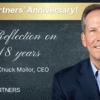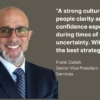Changing Course: The Leadership Shift
By Chuck Mollor
It happens to all of us at some point in our career. The formula for success we had utilized to date, and the strengths we had leveraged to be successful, need to be modified as we shift to a more senior role or as an organization and its culture evolve. This shift includes:
- How you budget your time
- How you prioritize and delegate
- How you influence your peers, boss, and other key stakeholders
- How you ensure you are strategic and focused on both short- and long-term goals
The shift to a larger role requires commitment to operating at the next level, but starts with reflection on what you need to change and a plan to implement those changes.
“Failing to plan is planning to fail.” – Anonymous
Economic volatility, uncertain markets, global competitors, rapid technological changes, and evolving employee expectations have made leaders’ jobs more unpredictable and demanding than ever. No scenario exists today in which leaders execute in a predictable environment. The traditional “5-year plan” is yesterday’s news that no one is reading, much less abiding by.
Below are steps to consider when shifting to a leadership role with greater responsibility and expectations:
Create time to think, plan, research, and connect with others. Schedule time weekly to think, reflect, plan, research, and be externally focused, and make a point to be known across the organization. Speak and meet with people enterprise-wide, as well as with clients and in the marketplace. Many managers are too internally focused — while it’s easy to become entrenched with daily management of tasks or tactical decisions, it’s not productive. You need to spend time looking externally at best practices, trends, and innovations or changes in your industry, and in other sectors that are impacting its success.
Identify your influencers. Who are the key people within the organization? Are they advocates for you? How are you developing these key relationships to be more visible, to understand their businesses, challenges, and opportunities? Are you investing in the time and dialogue to align them with your mission, vision, and strategy? This is an essential part of influence, relationship management, and strategy, but is easy to overlook. Pay attention to having influencers that represent the goals and challenges you want to address and ensure they understand your message, vision, and brand.
Build relationships. As mentioned above, it’s critical that you take the time to get to know influencers and decision-makers — people who can have an impact on your organization, initiatives, capabilities, resources, results, and your career. So, how can you do it?
Establishing trust and credibility with your team, peers, boss, and other key stakeholders in the organization gives you the capability to effectively influence, ask for input and feedback, and develop alliances, especially during critical times. You need these relationships to identify champions for ideas and initiatives. Establishing potential advocates and mentors will provide you with a sounding board, in addition to helping promote your ideas. If a leadership team is hearing your idea for the first time during a “big” meeting or presentation, you have not taken the time to test the strategy or build buy-in.
Successful leaders intentionally market themselves within their companies and across the enterprise. Though it may feel uncomfortable, awkward, or self-serving, you need to be visible and known by executives for potential succession and advancement, and to promote your team’s work. Find opportunities to meet with executives and learn about their responsibilities and the organizations they run. It’s an opportunity to educate yourself about parts of the business outside of your domain. Learn what success looks like for them, including what challenges they face, and what visions and strategies they have.
Guard your time. You can’t add hours to your day or week. Instead, take more control of your schedule, versus letting your schedule dictate where you spend your time. Are you stuck in back-to-back meetings or responding to endless emails? You can’t think, plan, be externally focused, and build relationships across the enterprise if you are tied up or too involved in the minute details. Shift where you spend your time by getting out of the weeds.
“Being overscheduled” can be a euphemism for being a micromanager. Recognize what you can let go of and how you can make your team accountable for certain levels of decision making. For many new leaders, spending time developing your bench and successors, building key relationships throughout your enterprise, and looking at the market, competition, best practices, trends, and disruptions, is unchartered territory that should now be on your agenda.
Have strategic dialogue. I’ve worked with a number of executives who tend to engage in more tactical and detailed conversations when discussing their organization, initiatives, and direction. A strategic, senior-level audience is anticipating a high-level discussion on strategy, innovation, and growth, and will tune out or disengage when things get in the “weeds”. If a fellow leader is curious about the details, you can follow-up with an executive summary. Strategic discussions should focus on the key takeaways, initiatives, potential opportunities, solutions, and lessons learned.
Be sure to engage in strategic dialogue about what others are doing. Think about creating your own “advisory board” to counsel you on how to continue to develop your people, your role within the organization, and best practices. While the marketplace is flooded with news, be sure to spend time tracking and paying attention to trends, disruptions, and the competition that could have a significant impact on your business.
This is a beneficial and practical way of giving yourself a reason to be visible across the enterprise, educating others on what you are accomplishing, and learning more about the business holistically.
Develop your culture and talent strategy. Leaders today need to have a strategy for their organizational culture. They must live and promote that culture to attract and retain talent that reflects the organization’s values and has the potential to achieve its vision, mission, and purpose.
A leader’s commitment to making the shift into a leadership position successful has many moving parts. It is important to recognize that success is not overnight and will require fine tuning and course correction. Being a continuous learner, being agile, and having a growth mindset will provide a launching point for the next level of success.
You can read more in Chuck Mollor’s best selling book, The Rise of the Agile Leader. Can You Make the Shift?
About MCG Partners
MCG Partners is a leadership and talent optimization firm– aligning your business and people strategy for maximum results. MCG Partners a woman-owned consultancy and is also a Predictive Index® (PI®) certified partner. To learn more please contact Stephanie Holmgren at stephanie.holmgren@mcgpartners.com and at mcgpartners.com








